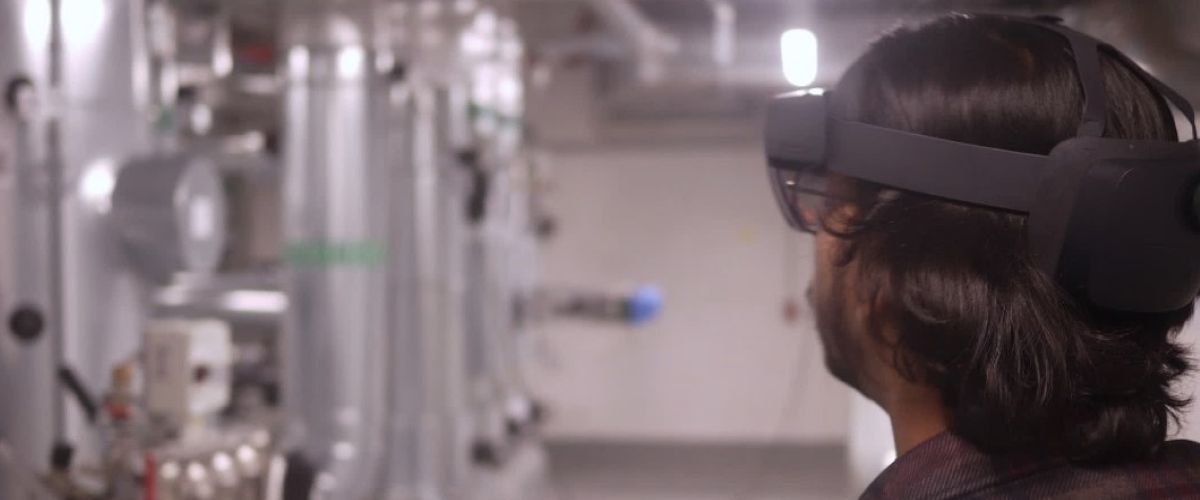 AGK | Koblenz, Debeka | Fotograf © mathias baumann. 2023
AGK | Koblenz, Debeka | Fotograf © mathias baumann. 2023
Artificial intelligence in building technology
Digital twin ensures more efficient operation of buildings
If a building and its infrastructure are virtually replicated, it is referred to as a digital twin. This simulates, for example, the ideal operation of an air conditioning system and adjusts the control of the system if it runs inefficiently. A new building in Koblenz demonstrates how this works.
The clients in Koblenz relied on digitalisation right from the construction and commissioning of the new building. Whether it was the shell, plumbing or electrics, all the trades involved were planned digitally and model-based using the Building Information Modeling (BIM) method.
For the commissioning, the experts recorded the actual state and compared it with the planning model. All data is now available via a cloud, even on site. The advantages of this approach are that the current status can be viewed by all parties at any time. This helps to avoid clashes between the components of the various trades and speeds up the construction process. A new administrative building for around 1,350 employees of the capital management company Aachener Grundvermögen has been built on the site of the former State Office for Surveying and Geoinformation in Koblenz.
 © TEMA AG
© TEMA AG
The project partner also benefited from the findings of the energyTWIN project. These make it possible to create and update digital building models. However, the methods developed in energyTWIN go one step further: they also include the building technology and its operation. To do this, the researchers, led by RWTH Aachen University, first labelled the technology in a standardised way and then recorded it digitally using sensors. The result is a digital twin of the entire building with its devices, systems and their connectivity. Current data and information from the systems are continuously fed into the cloud. The building operates twice: once in the real building and once in the virtual version.
Software can compare and synchronise operating conditions
This type of digital link optimises ongoing operations by continuously and automatically comparing actual and target operating states. As a result, the facilities and systems, such as air conditioning, heating or lighting, work more efficiently and cost-effectively – and contribute to climate protection and sustainability. Their use makes particular sense in larger properties with complex technical building equipment. These can be production plants, hospitals or office buildings.
In addition, a digital twin can simulate changes in the system. This is the case, for example, when a building is to serve as an energy source or storage facility. Complex control systems are often used for this. The linkage of the virtual and real world provides support during planning, commissioning and operation.
AI for facility managers and equipment manufacturers
Facility managers and technicians benefit from the use of artificial intelligence: the more transparent processes and systems are, the better AI can understand the building and its interrelationships and optimise processes. Malfunctions are directly identified by the digital coupling and can be remedied. ‘If problems occur with the systems, the provider is automatically digitally informed. They can promptly send a customer service technician who, for example, has the right spare part with them. If faults are detected early, costs can be saved, including those of consequential damage,’ explains Professor Joachim Seifert from the TU Dresden and TU Berlin. He heads the DZWI project. Here, too, the focus is on the topic of digital twins, but the main emphasis is on the benefits for device manufacturers and energy suppliers.
The aim of the DZWI is to enable manufacturers to monitor and optimise the devices they sell, such as heat pumps or fuel cell heating systems, throughout their entire product life cycle. In addition, the digital twin makes it possible to integrate many other product groups. ‘A platform is being created that also has an inter-face to the energy supplier. This creates added value for all parties involved: energy suppliers can plan more proactively and thus, for example, make better use of the low-voltage grid. Device manufacturers are given the opportunity to continuously optimise their systems,’ says Seifert.
Digital twins are not only used in buildings. There are many other areas of application in the energy sector, such as fault diagnosis and prediction in power grids and in grid management, maintenance planning and power optimisation in power plants, or process optimisation and product development in industry.
